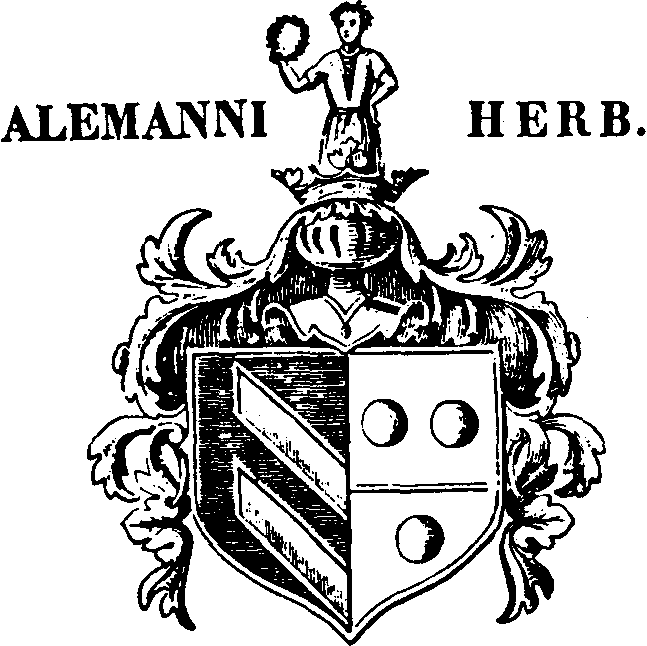Herb Alemanni
Research Heraldry Herb Alemanni
Herbarz Polski translation
Alemanni herb
 The following article is a direct translation from the classic Genealogical and Heraldic reference "Herbarz Polski" by Kasper Niesiecki S.J., (Lipsk) edition 1839-46.
The following article is a direct translation from the classic Genealogical and Heraldic reference "Herbarz Polski" by Kasper Niesiecki S.J., (Lipsk) edition 1839-46.
The shield is divided vertically: on its right side, two paths run diagonally from right to left downward, separated by a space equal to their width; the left side is in two parts: the upper displays two cannon balls; the lower part, one. Above the helmet, a young woman stands, crowned with a laurel wreath which rests on her ears per old custom, with one hand on hip and the other raised, in which she holds another laurel wreath. No one has described the color of shield, field, nor cannon balls.
This coat of arms was granted in Hertruria for some significant service. The source is clear because the Princes of Florence carry cannon balls in their coats of arms: five are red in a field of gold, and the sixth above them is blue. From it, three lilies rise. There is a gold crown above the helmet, a red lily on its peak, on which a silver falcon stands on its left leg, holding a gold ring in his right leg, and in his beak, a card, on which the word, Semper (always), is written. Additional proof of this family's arrival from Hertruria is a letter of 1566 from King Zygmunt August to Dominik ALEMANNI conferring rights of citizenship in our kingdom. You will find it verbatim in Paprocki. I will quote only what may add to information about the family: (Translator's Note: The paragraph is in Latin and herein deleted.) This testimony does not speak highly enough of a family which numbered two Roman Cardinals.
The first was ALEMANNUS Adimarius of Florence, son of Philip Adimarius Alemannus and Olimpia Fortiquerta. After a year as Bishop of Florence, he became Archbishop of Taranto, and then, of Pisa, where he was awarded the Cardinal's hat by John XXIII (translator's note: deposed by Council of Constance) for his courageous service as the Pope's legate in France. At the Councils in Pisa and Constance, ALEMANNUS zealously defended God's Church against the schismatics until, in the midst of these arduous efforts, he became seriously ill, some say, poisoned, and died in 1422. His body is buried in Rome. LOUIS ALEMANNUS was Bishop of Maglie and after a short time as Archbishop, Pope Martin V named him Cardinal. After the death of Pope Eugene, in order to bring peace to the church, ALEMANNUS persuaded Felix the anti-Pope, to put down the usurped Papal Miter. Exhausted from a myriad such cares, he departed in 1450 from the crown these labors earned him. The holiness of his life and numerous miracles worked before his tomb are being reported: that through his intercession sight is restored to the blind, speech to the mute, health to the sick, and often, life to the dead. The record of these graces has filled a sizeable book. Pope Clement VII wrote of his illustrious life in 1527.
In addition, there was ALOIZY ALEMANNI, a known historian, and Chamberlain of Catherine Medici, queen of France. His son, Karol, served King Henry of Poland, and later, of France, as Chamberlain. Karol's brother was a Bishop in France. The first of this family to settle in Poland was DOMINIK ALEMANNI, squire of Gawronowo, Piotrkowic and Lyszkowice; Master of the Pantry in Lublin; head of a county in Mazowsze. He was King Stefan's envoy to King John of Sweden. Dominik married the sister of Fanuel, Master of Pantry in Lublin, and left sons worthy of his example: Stanislaw, who died a young man, in Krakow, and is buried in the cemetery of the Franciscan Fathers where Starowolski copied the inscription on the tombstone; and Zygmunt, who voted for Wladyslaw IV in 1632 with the voivodship of Sieradz.
Shortly after this year, the family returned to Italy. Not so long ago, during my own time, an ALEMANNI, Roman Provincial, nephew of Pope Clement XI, and a man of great attributes, furnished the monastery of the Society of Jesus. He would mention that his grandfather was born in Poland and had moved from there to Italy.
Copyright © 1980 Josephine M. Piegzik. Used by permission. This article originally appeared in Polish Genealogical Society Newsletter (Vol. 2, No. 1, January 1980), the journal of the Polish Genealogical Society (of America).
;
